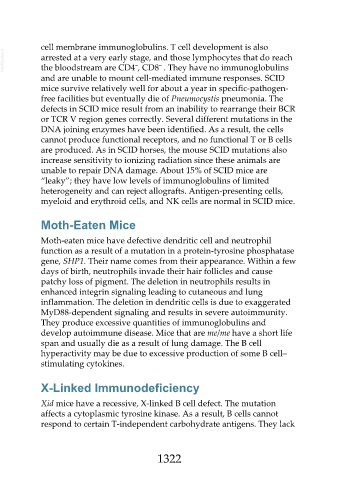Page 1322 - Veterinary Immunology, 10th Edition
P. 1322
cell membrane immunoglobulins. T cell development is also
VetBooks.ir arrested at a very early stage, and those lymphocytes that do reach
−
−
the bloodstream are CD4 , CD8 . They have no immunoglobulins
and are unable to mount cell-mediated immune responses. SCID
mice survive relatively well for about a year in specific-pathogen-
free facilities but eventually die of Pneumocystis pneumonia. The
defects in SCID mice result from an inability to rearrange their BCR
or TCR V region genes correctly. Several different mutations in the
DNA joining enzymes have been identified. As a result, the cells
cannot produce functional receptors, and no functional T or B cells
are produced. As in SCID horses, the mouse SCID mutations also
increase sensitivity to ionizing radiation since these animals are
unable to repair DNA damage. About 15% of SCID mice are
“leaky”; they have low levels of immunoglobulins of limited
heterogeneity and can reject allografts. Antigen-presenting cells,
myeloid and erythroid cells, and NK cells are normal in SCID mice.
Moth-Eaten Mice
Moth-eaten mice have defective dendritic cell and neutrophil
function as a result of a mutation in a protein-tyrosine phosphatase
gene, SHP1. Their name comes from their appearance. Within a few
days of birth, neutrophils invade their hair follicles and cause
patchy loss of pigment. The deletion in neutrophils results in
enhanced integrin signaling leading to cutaneous and lung
inflammation. The deletion in dendritic cells is due to exaggerated
MyD88-dependent signaling and results in severe autoimmunity.
They produce excessive quantities of immunoglobulins and
develop autoimmune disease. Mice that are me/me have a short life
span and usually die as a result of lung damage. The B cell
hyperactivity may be due to excessive production of some B cell–
stimulating cytokines.
X-Linked Immunodeficiency
Xid mice have a recessive, X-linked B cell defect. The mutation
affects a cytoplasmic tyrosine kinase. As a result, B cells cannot
respond to certain T-independent carbohydrate antigens. They lack
1322

